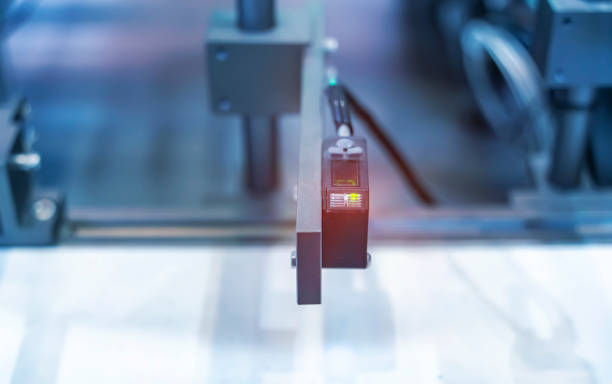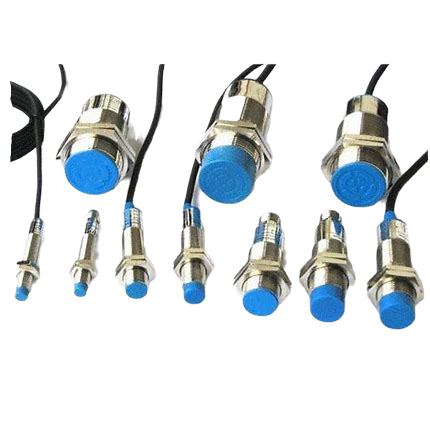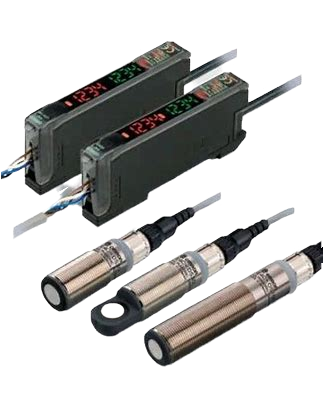Omron Proximity sensors
13.06.2024
Within the dynamic field of industrial automation, the need for precision and reliability has never been more critical. Omron inductive proximity sensor stand out as pivotal components, driving innovation and efficiency across a spectrum of industries, including manufacturing, automotive, packaging, and robotics.
Omron’s commitment to excellence is reflected in the advanced features and robust design of their proximity sensors, which deliver consistent and reliable detection capabilities. These sensors not only enhance operational efficiency but also bolster safety and productivity, making them indispensable in today’s industrial environments.
The importance of proximity sensors in industrial automation

The foundation of modern manufacturing and production processes is industrial automation. It entails utilizing information technologies and control systems, including computers and robotics, to manage various machinery and processes in an industry. Here are some key reasons why industrial automation is vital:
Increased Productivity and Efficiency: By facilitating continuous operation and reducing downtime, automation greatly increases production. Machines and robots can work faster and longer than humans, leading to higher output levels.
- Improved Quality and Consistency: Automated systems ensure products are manufactured to the same specifications every time, reducing variability and enhancing quality control. For sectors where accuracy is critical, such as the automobile and electronics industries, this constancy is essential.
- Cost Reduction: Automation can have a large upfront cost, but it also offers significant long-term benefits. Lower labor expenses, less waste, and optimal resource utilization are all achieved by automation, which also lowers manufacturing costs.
- Enhanced Safety: Industries can lower the risk of workplace injuries and shield their workers from hazardous conditions by automating harmful operations. More safely than humans, automated systems can manage high temperatures, hazardous materials, and heavy lifting.
- Flexibility and Scalability: Modern automated systems are highly adaptable and can be reprogrammed for different tasks. This flexibility allows manufacturers to respond swiftly to market changes and scale production up or down as needed.
- Data Collection and Analysis: Massive volumes of data are collected by sensors and monitoring technologies that are part of automation systems. Improved decision-making, predictive maintenance, and ongoing process improvement can result from the analysis of this data.
Omron Proximity Sensors' Function in Automation
A key component of industrial automation's success is proximity sensors. These sensors are essential in many applications because they can identify the presence or absence of items without coming into touch with them. Here’s how they contribute to automation:
- Object Detection: The purpose of proximity sensors is to find items within a given range. This capability is essential in automated assembly lines, where precise object placement and detection are critical for smooth operation.
- Positioning and Alignment: Accurate positioning is vital in many manufacturing processes. Proximity sensors help in the precise alignment of parts and components, ensuring that each piece is correctly placed before the next phase of production.
- Safety and Security: By identifying the presence of objects or persons in potentially dangerous regions, proximity sensors improve workplace safety. They can trigger automatic shutdowns or alarms when an object is detected in a danger zone, preventing accidents and equipment damage.
- Counting and Sorting: In industries such as packaging and material handling, proximity sensors are used to count and sort items. This function ensures accurate inventory management and efficient sorting of products based on predefined criteria.
- Preventive Maintenance: Proximity sensors can monitor machine parts' wear and tear by detecting minute changes in positioning or vibration. This data helps predict when maintenance is required, preventing unexpected breakdowns and extending equipment lifespan.
- Quality Control: Proximity sensors are essential to quality control since they verify that parts are present and positioned correctly. They ensure high-quality output and minimize waste by assisting with the early detection of abnormalities or flaws in the production process.
What are proximity sensors?
Proximity sensors, sometimes referred to as non-contact sensors, are electrical devices that identify if an object is present or absent without coming into direct contact with it. They are employed in many different industrial settings for quality assurance, process automation, and safety.
Types of Omron Proximity Sensors
Different materials and applications are better suited for different kinds of proximity sensors. The primary types include:
- Inductive Proximity Sensors: By producing an electromagnetic field, these sensors are able to identify metallic things. The characteristics of a metal object change when it enters the field; the sensor recognizes this change and uses it to initiate a reaction.
- Sensors of Capacitive Proximity: Capacitive sensors monitor changes in capacitance when an object approaches the sensing surface of the sensor. These sensors are capable of detecting both metallic and non-metallic things.
- Sensors of Photoelectric Proximity: These sensors use an infrared light beam and measure variations in the beam to identify things. The sensor detects the existence of an object when it blocks the beam.
- Ultrasonic Proximity Sensors: These sensors measure the amount of time it takes for high-frequency sound waves to return after striking an item. They may identify a variety of materials with this technique, including solids, liquids, and granular particles.

The working principle of proximity sensors
Omron inductive proximity sensor work according to different principles, but they are all based on detecting a change in a physical quantity when an object approaches the sensor. Here are some of the most common operating principles:
1. Electromagnetic field
Inductive sensors: These sensors track variations in the electromagnetic field an inductor produces. When a metal object approaches the coil, it changes the inductance, which results in a change in the electric current passing through it. This change in current is used to detect the presence of an object.
Magneto-resistive sensors: These sensors make use of magneto-resistive components, whose resistance varies when a magnetic field is present. An electromagnet or permanent magnet can produce a magnetic field. An object's presence is determined by a change in resistance.
2. Capacity
Capacitive sensors detect changes in the capacity of the capacitor that occurs when the object approaches. The dielectric constant of the object affects the capacity of the capacitor. The change in capacitance is used to detect the availability of the object.
3. Optical signal
Photoelectric sensors detect changes in the intensity of light reflected from an object. The sensor consists of a light source (usually an LED) and a photodetector (usually a phototransistor). As the object approaches the sensor, it changes the amount of light that reaches the photoreceptor. This change in intensity is used for detection availability of the object.
4. Ultrasound
Ultrasonic sensors detect changes in the time of passage of an ultrasonic signal. An ultrasonic pulse is produced by the sensor, which bounces off the item and returns to it. The closer the object, the less time is needed to return the signal. This time change is used for determining the distance to the object.
Additional factors: In addition to the main principle of operation, proximity omron can have additional ones features such as:
- Material Type Detection: Some sensors can detect the type of material an object is made of.
- Shape detection: Some sensors can detect the shape of an object.
- Detection of multiple objects: Some sensors can detect multiple objects at the same time.
Why Choose Omron Proximity Sensor?
Choosing the appropriate proximity sensors for industrial automation is essential to guaranteeing maximum performance and dependability. Proximity sensors from Omron, a pioneer in industrial automation systems, are notable for their exceptional quality, cutting-edge features, and wide range of applications. The following are the reasons why industries all around the world choose Omron proximity sensors:
- High Accuracy and Precision: Omron proximity sensors are made to detect things with extreme precision and accuracy. This increases the overall effectiveness of automated systems by guaranteeing that even the tiniest changes in position or presence are precisely recorded.
- Robust and Durable Design: Built to withstand harsh industrial environments, Omron sensors feature robust construction that resists dust, water, vibrations, and extreme temperatures. This durability ensures long-term reliability and reduces the need for frequent replacements.
- Wide Range of Sensing Distances: Omron offers proximity sensors with a variety of sensing distances, ranging from a few millimeters to several meters. This versatility allows for the sensors to be used in diverse applications, from close-range detection to broader area monitoring.
- Fast Response Time: Omron proximity sensors are perfect for high-speed automation processes because of their quick response times. Their ability to promptly identify things and provide signals to the control system guarantees prompt and effective operations.
- Advanced Technology: Omron integrates cutting-edge technology into their sensors, including features like noise immunity, temperature compensation, and self-diagnosis capabilities. These advancements enhance the performance and reliability of the sensors in complex industrial settings.
- Easy Integration and Compatibility: The architecture of Omron proximity sensor makes it simple to integrate them with current automation systems. They give flexibility in terms of system compatibility and setup by offering a variety of output types, including NPN, PNP, and analog.
Applications of Omron Proximity Sensors
Omron proximity sensors are used across a wide array of industries, thanks to their reliability, precision, and versatility.
- Manufacturing Industry: In manufacturing, proximity omron are essential for position detection, part presence verification, and quality control. They help in monitoring machinery, detecting assembly errors, and ensuring the correct placement of components.
- Automotive Industry: Omron sensors are used in safety systems, assembly line automation, and part detection in the automotive industry. In order to guarantee accurate assembly procedures and improve worker and equipment safety, these sensors are essential.
- Packaging Industry: In packaging, Omron proximity sensor detect the presence of packaging materials, control the movement of packages, and ensure accurate labeling and sealing. This improves the efficiency and accuracy of packaging operations.
- Robotics and Automation: Proximity omron play a major role in navigation, obstacle identification, and task execution for robotics. Robots can carry out intricate operations with extreme precision thanks to Omron sensors, which increases the efficiency of automated systems.
- Food and Beverage Industry: Omron sensors are used in the food and beverage industry for detecting the presence of containers, ensuring the correct filling levels, and monitoring the movement of products on conveyors. Their ability to withstand washdowns and high humidity conditions makes them ideal for this sector.
- Pharmaceutical Industry: In the pharmaceutical industry, omron prox sensor ensure accurate counting, sorting, and packaging of medicines. Their precision and reliability are crucial in maintaining high standards of quality control and compliance with regulations.
Datasheet of Omron proximity sensors
Omron provides a broad selection of proximity sensors with various features to satisfy various requirements. Here are some of the the most important characteristics that should be taken into account when choosing Omron sensor:
1. Sensor type
- Inductive: These sensors detect metal objects. They have a strong body and are resistant to environmental influences.
- Capacitive: Any object, including liquids, metals, and plastics, can be detected by these sensors. Their accuracy and sensitivity are excellent.
- Photoelectric: These sensors detect objects by interrupting a beam of light. They have a wide detection range and can be used in low light conditions.
- Ultrasonic: These sensors detect objects by measuring the travel time of an ultrasonic signal. They can detect objects in smoky or dusty conditions.
2. Detection range
The detection range is the distance at which the sensor can detect the object. Omron offers range sensor detection from a few millimeters to several meters.
3. Sensor size
Sensor size is an important factor to consider if you have limited space. Omron offers sensors in various housings, including M5, M8, M12, M18 and M30.
4. Output type
The output type of the sensor determines how it signals about object detection. Omron offers sensors with different output types, including PNP, NPN, NO, NC and analog.
5. Supply voltage
The supply voltage of the sensor is the voltage required for it work Omron offers sensors with different voltages power supply, including 12V DC, 24V DC current and AC.
6. Degree of protection
The degree of protection of the sensor is indicated by the IP code, which indicates its resistance to dust and water penetration. Omron offers sensors with different degrees of protection, including IP67 and IP69K.
7. Additional features
Omron offers sensors with various options and characteristics, such as:
- Material Type Detection: Some sensors can detect the type of material an object is made of.
- Shape detection: Some sensors can detect the shape of an object.
- Detection of multiple objects: Some sensors can detect multiple objects at the same time.
- IO-Link: Some sensors support IO-Link, a communication protocol that provides more flexibility and diagnostic capabilities.
Purchasing Omron Proximity Sensors
When investing in industrial automation products, it is essential to purchase from authorized representatives to ensure authenticity, quality, and reliable support. Omron proximity sensor, known for their precision and durability, should be sourced from trusted distributors who can guarantee genuine products and provide comprehensive customer service. One such trusted company is Eltra Trade, which offers a vast selection of omron prox sensor.

A Trusted Source for Omron Proximity Sensors
Eltra Trade is a reputable and trusted supplier of industrial automation products, including a wide range of omron prox sensor. Here’s why Eltra Trade is the ideal choice for your Omron sensor needs:
- Extensive Selection: Eltra Trade offers a comprehensive selection of Omron proximity sensor, ensuring that you can find the right sensor for your specific application requirements.
- Customer Trust: With a strong reputation for reliability and customer satisfaction, Eltra Trade has earned the trust of clients worldwide. Their commitment to quality and service makes them a preferred partner for industrial automation products.
- Competitive Pricing: Eltra Trade offers affordable prices on all Omron products, guaranteeing that you will receive the most out of your investment.
- Fast Delivery: With efficient logistics and supply chain management, Eltra Trade ensures the timely delivery of products, helping you keep your operations running smoothly.
Conclusion
Omron proximity sensor, supported by the reliable expertise of authorized distributors, offer a robust and dependable solution to elevate your industrial automation capabilities. Whether you require unparalleled precision in object detection, resilient performance in challenging environments, or the latest technological advancements, Omron sensors deliver the excellence and reliability that are essential for today’s industrial demands.